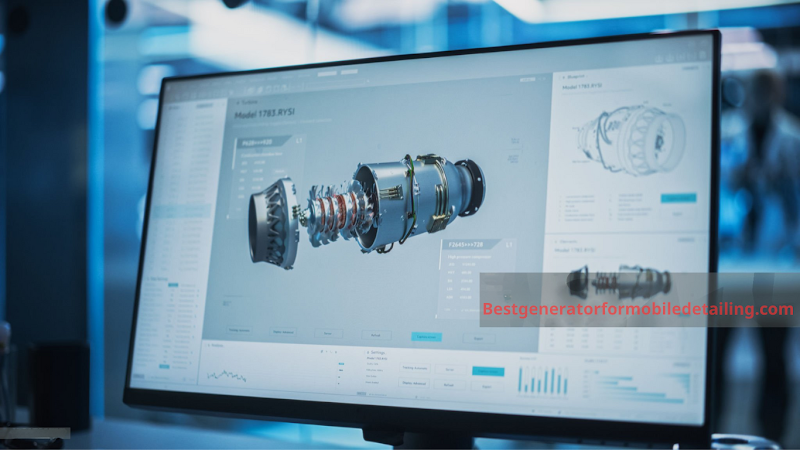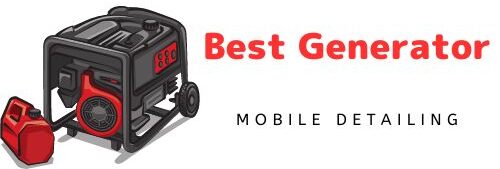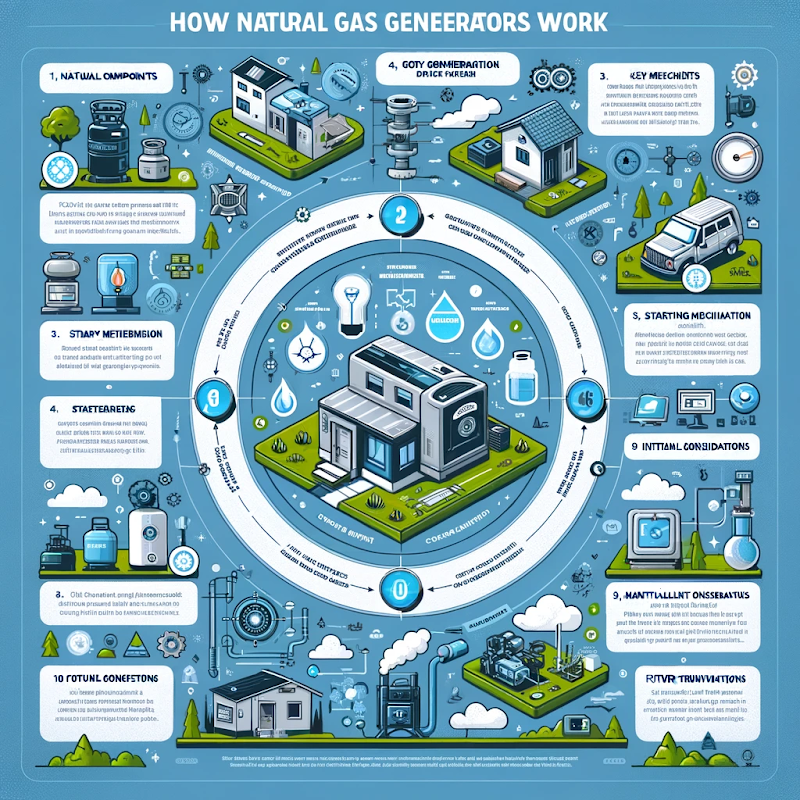Understanding how a natural gas generator works are crucial for anyone considering its use for reliable power solutions. These generators’ core is a well-orchestrated system that effectively converts natural gas into electrical energy. The engine designed for the combustion of natural gas is the beginning of this particular process.
The air-fuel system, combustion chamber, pistons, and alternator are major components. All these components are very crucial in the process of converting chemical energy in the fuel to mechanical, which is finally converted to produce electricity. Understanding the intricate workings of those components is key in understanding how natural gas generators are able to afford to be reliable and efficient with residential, commercial, and industrial applications.
Components of a Natural Gas Generator

The best generator for mobile detailing will give a better understanding of how this type of generator works. It needs to be broken down into its components, which are essential to its operation. Key components help in the whole process of a natural gas generator Key components of a generator include:
- Engine: An engine is the drivetrain of a natural gas generator. It is designed to burn natural gas and convert chemical energy into mechanical energy. A typical generator engine is four-cycle, similar to automobile engines, which is why the engines are not only powerful but efficient.
- Air-Fuel System: This supplies a percentage of air and natural gas mixture to the engine for combustion. It’s responsible for mixing the right proportion of natural gas with air for proper combustion. The ignition of this air-fuel mixture kicks off the power generation cycle.
- Combustion Chamber: This is where the actual gas burning takes place. In this enclosed area, the gas is burnt to produce the force that will move the pistons up and down and produce this mechanical energy.
- Pistons and Crankshaft: The combustion force drives the pistons, pushing them up and down in the engine cylinders. The pistons are linked to the crankshaft. All the linear motion the pistons produce is transformed into rotary motion, which will be crucial in the next step of the energy conversion.
- Alternator: The alternator is also called the generator head. The alternator converts mechanical energy from the crankshaft into electrical energy. It is composed of a rotor that rotates inside the stator, a stationary part. Alternatively, the movement of the rotor in the magnetic field that bounds it through electromagnetic induction will produce an electric charge.
- Voltage Regulator: This component is responsible for maintaining the electrical output of the generator at a constant voltage. It offers voltage regulations and, in turn, prevents the attached electrical devices from getting spoilt.
- Control Panel: The control panel is an interface for the user to access the generator appliances. This part allows the user to power on or off the generator, monitor the performance metrics, and control many settings.
- Exhaust System: This system expels the gases that are safely formed during combustion from the generator. This ensures that the whole operation is smooth, efficient, and safe.
- Cooling System: A cooling system in the generator helps in preventing the engine from getting overheated. This cooling system helps in maintaining the temperature of the engine within the safe operating limits.
A Detailed Working of a Natural Gas Generator

Now, natural gas generators are complex devices, with the working starting right from the moment the device is turned on.
Fuel Introduction and Air Mixing: Natural gas is drawn from the gas line, usually the fuel source, and allowed to enter the generator. The gas in this air-fuel system mixes with air in a precisely controlled ratio to deliver complete and efficient combustion.
Ignition: The ignition system consists of spark plugs that help ignite the air and fuel mixture within the combustion chamber. This ignition process is followed by a series of controlled explosions.
Combustion and Piston Movement: These controlled explosions result in high-pressure gas, which forces the piston downwards inside the cylinder. Such movement is what results in the transmission of chemical energy in the fuel into mechanical energy.
Crankshaft Rotation: The crankshaft converts the linear motion of the pistons into rotational motion. This is the main reason rotational motion is attached directly to the alternator in the generator.
Electric Power Generation: The stator contains a rotor that rotates along with the crankshaft. The rotation of the rotor and the static magnetic field interact in an invention to cause an electric current. The raw electricity generated in the process is referred to as electrical power.
Voltage regulation: In the course of generation, the electricity goes through a voltage regulator, which ensures the voltage is regular and at a level that is safe for use at home and in businesses.
Distribution: Circuits are connected to appliances, lights, and other electric systems that use electricity, and this regulated electrical power is distributed. The generator’s output can be easily controlled and monitored from the control panel to ensure that it is produced efficiently to meet the demand.
Advantages of Natural Gas Generator

The following are the benefits of natural gas generators hence being their best for residential and commercial uses:
Fuel Efficiency: Natural gas generators are highly fuel-efficient generators. The natural gas burns and creates energy very cleanly and completes the burning of the fuel. Low fuel is wasted and more is converted into energy.
Lower Emissions: Natural gas generators generally emit fewer pollutants than generators powered by diesel. Natural gas-powered models produce much less sulfur dioxide, nitrogen oxides, and particulate matter that could harm the environment.
Cost-effective: Natural gas is also cheaper compared to other fossil fuels. Additionally, generators powered by natural gas are, in most cases, more cost-efficient to maintain and, hence, lower in general operation costs.
Convenience of Fuel Supply: A residence or business whose infrastructure connects to the main infrastructure will enjoy an uninterrupted and reliable fuel supply, eliminating the need for storage tanks and the inconvenience of fuel deliveries.
Reliability: Natural gas generators are known to be reliable, providing consistent power during outages. This makes them an excellent choice for backup power solutions.
Low Noise Operation: These generators are generally quieter than their diesel-powered counterparts. As a result, they can be used in residential areas where noise could be a concern.
Applications of Natural Gas Generator
Natural gas generators are very flexible in their applications and can be used in various settings to either offer backup power or even be used as the prime source of power itself.
Residential: Homeowners can get fantastic peace of mind from having natural gas generators available during long power outages. It can make one able to conduct daily routines with no worry at all.
Commercial: Businesses can continue to run during power outages with natural gas generators. This is very critical, especially in businesses where there has to be a continuous power supply, such as health facilities, manufacturers, and data centers.
Industrial: Naturally, industrial operations require much power consumption and high reliability. Natural gas generators are specifically designed to meet such high demands in an efficient way.
Emergency services: Hospitals, fire stations, and other emergency service providers rely on natural gas generators to ensure the availability at any time of the critical services in case of failure in the electrical power supply system.
Remote locations: In regions where accessing the electrical grid has proved difficult, natural gas generators will prove to be a power supply they can rely on.
Conclusion
Knowledge of a natural gas generator’s workings explains such machines’ complicated and efficient workings. The natural gas generator offers reliable, effective, and environmentally friendly power solutions by converting natural gas into electrical energy in coordination with well-sequenced steps. Poor residential, commercial, and industrial applications, the advantages derived from such applications of natural gas generators, are an excellent option for those needing a reliable backup or prime power source. These, coupled with the lower emissions, convenience of continuous fuel supply, and value of their fuel efficiency, are evidence that continuous energy would be considered today.
Marion Woods is an accomplished generator technology expert with over 15 years of experience, currently serving as the Chief Technology Officer at GenTech Power Solutions. She holds a Master’s degree from MIT and specializes in enhancing generator efficiency and integrating renewable energy sources. Marion is a respected author and speaker in the engineering community, dedicated to pioneering sustainable power solutions.


1 thought on “How Does a Natural Gas Generator Work?”